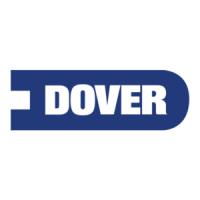WILDEN PUMP & ENGINEERING, LLC 18 WIL-12350-E-02
REASSEMBLY HINTS & TIPS
Description of Part H1500 HS Stainless Steel H1500 HS Ductile Iron
Inner Piston Bolts* 58.3 N•m (43 ft-lb) 58.3 N•m (43 ft-lb)
Outer Piston 140 N•m (103 ft-lb) 140 N•m (103 ft-lb)
Air Valve Bolts 9.5 N•m (84.1 in-lb) 9.5 N•m (84.1 in-lb)
Inlet/Discharge Manifold Bolts 17.6 N•m (13 ft-lb) 163 N•m (120 ft-lb)
Center Section Cover Bolts 54.0 N•m (40 ft-lb) 54.0 N•m (40 ft-lb)
Air Chamber Bolts* 88.1 N•m (65 ft-lb) 163 N•m (120 ft-lb)
Liquid Chamber Bolts 58.3 N•m (43 ft-lb) 163 N•m (120 ft-lb)
REASSEMBLY:
Upon performing applicable maintenance to the air distribution
system, the pump can now be reassembled. Please refer to the
disassembly instructions for photos and parts placement. To reas-
semble the pump, follow the disassembly instructions in reverse
order. The air distribution system needs to be assembled first, then
the diaphragms and finally the wetted path. The following tips will
assist in the assembly process:
• Lubricate air valve bore, center section shaft and pilot spool
bore with NLGI grade 2 white EP bearing grease or equivalent.
• Clean the inside of the center section shaft bore to ensure no
damage is done to new shaft seals.
• A small amount of NLGI grade 2 white EP bearing grease can be
applied to the muer and air valve gaskets to locate gaskets
during assembly.
• Make sure that the exhaust port on the muer plate is cen-
tered between the two exhaust ports on the center section.
• Stainless bolts should be lubed to reduce the possibility of seiz-
ing during tightening.
• Use a mallet to tap lightly on the large clamp bands to seat the
diaphragm before tightening.
NOTE: To ensure proper
alignment during reassembly
of manifold/liquid chamber
interface, turn off-set portion
of valve housing to the left or
to the right. This procedure
works for the inlet mani-
fold and discharge manifold
connections.
MAXIMUM TORQUE SPECIFICATIONS
OFF-SET
VALVE
HOUSING
TWIST
SHAFT SEAL INSTALLATION:
PRE-INSTALLATION:
Once all of the old seals have been removed, the inside of the
bushing should be cleaned to ensure no debris is left that may
cause premature damage to the new seals.
INSTALLATION:
The following tools can be used to aid in the installation of the
new seals:
Needle-Nose Pliers | Phillips Screwdriver | Electrical Tape
• Wrap electrical tape around each leg of the needle-nose pliers
(heat shrink tubing may also be used). This is done to prevent
damaging the inside surface of the new seal.
• With a new seal in hand, place the two legs of the needle nose
pliers inside the seal ring. (See Figure A.)
• Open the pliers as wide as the seal diameter will allow, then
with two ngers pull down on the top portion of the seal to
form kidney bean shape. (See Figure B.)
• Lightly clamp the pliers together to hold the seal into the kid-
ney shape. Be sure to pull the seal into as tight of a kidney shape
as possible, this will allow the seal to travel down the bushing
bore with greater ease.
• With the seal clamped in the pliers, insert the seal into the bush-
ing bore and position the bottom of the seal into the correct
groove. Once the bottom of the seal is seated in the groove,
release the clamp pressure on the pliers. This will allow the seal
to partially snap back to its original shape.
• After the pliers are removed, you will notice a slight bump in
the seal shape. Before the seal can be properly resized, the
bump in the seal should be removed as much as possible. This
can be done with either the Phillips screwdriver or your nger.
With either the side of the screwdriver or your nger, apply
light pressure to the peak of the bump. This pressure will cause
the bump to be almost completely eliminated.
• Lubricate the edge of the shaft with NLGI grade 2 white EP
bearing grease.
• Slowly insert the center shaft with a rotating motion.
• This will complete the resizing of the seal.
• Perform these steps for the remaining seals.
Figure A
SHAFT SEAL
TAPE
Figure B
SHAFT SEAL
TAPE
NEEDLE NOSE
PLIERS
*Use #242 removable Loctite® on fastener threads.

